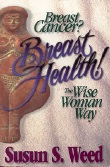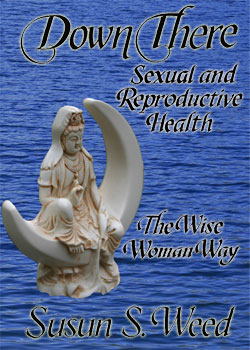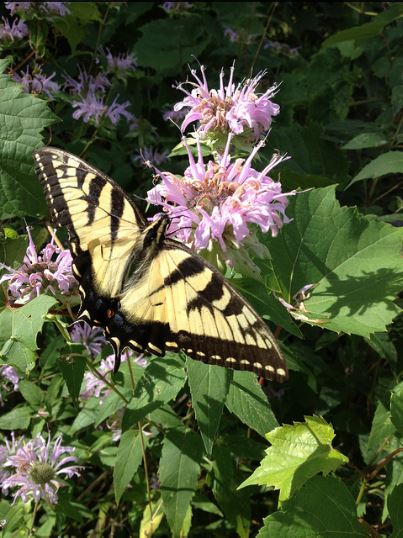 Glorious green greetings to you all!
Glorious green greetings to you all!
We saw the first orange leaves this morning as we opened our usual talking stick ceremony by singing "Sacred Corn Mother." (We love you, we miss you, Lisa Thiel.) The First Harvest Feast is upon us. Autumn has officially begun.
Have the weeds taken over your garden? Time to harvest, harvest, harvest!
Is the golden rod threatening to overpopulate the world? Time to harvest, harvest!
Are you excited to be reclaiming People's Medicine, the medicine outside your door, as your medicine? Time to harvest, harvest, harvest!
It's a great time to harvest mints and make vinegars and honeys: peppermint, sage, rosemary, thyme, shiso, lemon balm, peppermint, and bergamot, also known as bee balm.
Bee balm is a Monarda, a fascinating genus of the mint family. The apprentices and I made Monarda vinegar in July and will more this month, too. Vinegar preserves the anti-oxidant, anti-infective qualities of all the mints, plus it extracts the minerals that they concentrate. Bergamot vinegar aids digestion, fights infection, and tastes great on my salad or my beans. Herbs I harvest now will keep me well all winter.
Speaking of winter, I'm also trying out Fancy Aunt Bee's Bergamot Tincture. There is a lot of talk recently about the antiviral properties of many mints, including bergamot and skullcap. What will happen if I treat bergamot like a medicine instead of a food? I will keep you posted. And look forward to hearing from you. Are you using bergamot? How? Let me know.
I'll write again next week after the Green Goddesses are initiated as Green Witches. Until then, may you feel the plant breathing green blessings and may the healing cloak of the Ancients surround you with peace.
Bee Balm Sisters: the Monardas
Allow me to introduce you to the beautiful bee balm sisters, also know as the majestic Monardas. They come in many bright colors and have the most amazing scents. Yes, you're right, they are part of the mint family.
Gardeners love the bee balm sisters for their study self-reliance. Plant them almost anywhere (from British Columbia to Texas and from the Rocky Mountains to the Atlantic) and you can forget them . . . until they delight you with masses of aromatic blooms tended to by dozens of bees, butterflies, and hummingbirds.
Herbalists love the bee balm sisters for their ability to ease digestive and respiratory woes, and counter inflammation, too. A cup of hot or cold bee balm tea, of the fresh or dried leaves or flowering tops, or several spoonfuls of bee balm vinegar can help release gas from the intestines (carminative), encourage gut flora (digestive), move mucus in the lungs (expectorant), encourage sweating (diaphoretic), counter fevers (antibacterial febrifuge), counter cramps (antispasmodic), strengthen the heart (cardiac tonic), promote health (antioxidant scavenger), help induce sleep (mild sedative), and improve urinary flow (mild diuretic).
The bee balm sisters help those troubled by indigestion, colic, gas pain, flatulence, diarrhea, nausea, vomiting, bloating, colds, sore throat, fever, headache, sinusitis, sore eyes, nosebleed, eczema, chills, bleeding gums, tooth decay, parasites, and backache. Breathe the fragrant steam of any bergamot to open to lungs, promote deeper breathing, counter bronchitis, and relieve lung congestion. Try a poultice against bee stings and headaches, skin eruptions (measles, chicken pox).
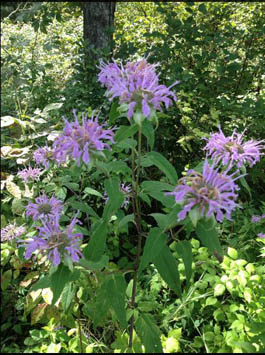
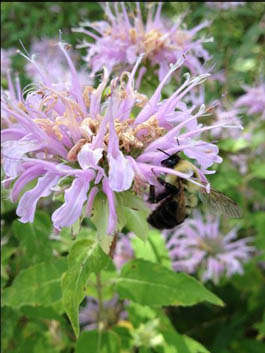
Scarlet bee balm, Oswego tea (Monarda didyma)
This is my favorite of the Monardas, and often the most difficult to find. It is considered endangered or threatened in parts of its range. The fragrance is neither minty nor oregano-y, neither citrus nor thyme, but partakes of all these with a soft and subtle sweetness. The long-lasting flower is a clear red with a hint of purple. Scarlet bee balm is my secret ingredient in comfrey infusion. One stalk of dried herb, with leaves and flowers is added to one ounce of dried comfrey leaf and infused in a quart of boiling water overnight. Be sure to use the scarlet bee balm, not the others; they are too rich in volatile oils. Some books suggest that scarlet bee balm gets bitter after it flowers, but I have not found that to be the case. (More on Oswego tea for the mentored students. Click here.)
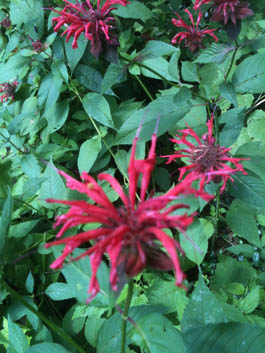
Wild bergamot (Monarda fistulosa)
This is the most common wild Monarda. It contains more thymol and oreganol than Oswego tea. This makes it more interesting as a medicine – and much stronger tasting – than its more red-flowered sister. Does this one become bitter if harvested after the flowers open? It is too late this year to test this idea out, but I shall endeavor to do so next year. I've always harvested the whole flowering top, dried it until crisp, crumbled the leaves and petals off the stalk and then used it in soups for a powerful antioxidant and a flavor enhancer. A wild bergamot leaf poultice was used by native people's to dry up pimples and other skin rashes. Herbalists in Colorado tincture their strongly scented, high altitude, powerful tasting wild Monarda and use it as an antiviral and anti-infective.
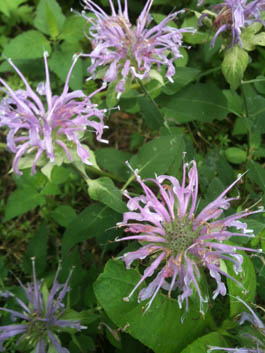
Cultivated bergamot (Monarda x)
The most commonly sold Monarda cultivars seem to be a cross between the lovely lilac fistulosa bergamot and the stately red didyma bergamot, with the resulting plants having far more oreganol and thymol than the pale purple fistulosa and not nearly as nice a taste as the scarlet red didyma. I admit to finding the colors of the cultivars rather off putting as well. Like the scent and the taste, the concentration of oils in cultivated Monardas is over the top. Too much, I say.
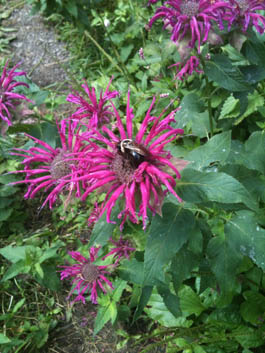
Horsemint (Monarda punctata)
I have yet to find this Monarda growing near to me, so no photo of it, but this plant is hard to miss. It looks like the other bergamots, but with wide-jawed yellow flowers dotted with small purple spots and held by bright white or lilac bracts. This one is loaded with volatile oils and is prized as a medicine. It contains more thymol than thyme itself does. I think I will buy a few plants of punctata from Richter's in Ontario and see if I can get it to grow in my garden. (They probably have didyma too, if you are looking for it.)
Fancy Auntie Bee's Bergamot Tincture
Auntie Bee: Antiviral, antiseptic, antibacterial, anti-inflammatory bergamot!
Harvest any bergamot when the sun is hot and it has been dry for a while.
- Chop the leaves and stalks coarsely and fill a jar very full with the plant material.
- Cover completely with 100 proof vodka.
- Lid, label, and wait six weeks.
- Put it up at Lammas, it's ready by Fall Equinox.
Start with a dose of 10 drops and increase as needed.
Try making one tincture before the plant flowers and another that includes the flowers.
Is there a difference? Which do you prefer?
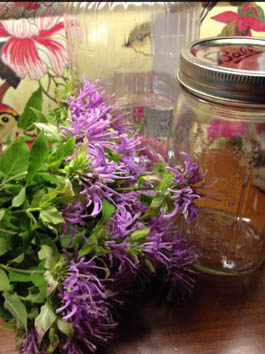
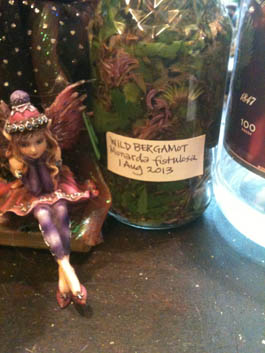
Shamanic plants
Here are a few of the many plants used worldwide by shamans to walk between the worlds. Being able to use psychoactive plants is, in fact, a prerequisite in many cultures to being trained as an herbalist or a shaman.
Fly agaric, the witches' mushroom (Amanita muscaria) [photo sent to us by Rose Weissman]
It's she a beauty?! This is a classic example of the fly agaric mushroom just emerging from its egg. This is the yellow form, the one common here on the east coast. If you live on the west coast, or in Europe, your Amanita muscaria mushrooms will have a red cap. A red cap with white dots, like those you see illustrating fairy stories, especially those featuring witches. (Chuckle.) And like those plaster or plastic ones who hang with plaster or plastic gnomes.
All Amanita mushrooms emerge from an egg-like sac of white material that clings in dots and dabs to the cap and remains around the base of the flaring stalk. As the cap matures and opens, the veil covering the under surface loosens and falls down around the stalk. (Mentored students, your core material this week includes photos of other Amanitas.)
Humans have been allied with fly agaric for thousands of years. Some sources claim it is the most ancient of all shamanic plants used by humans; others believe Brugmansia holds that honor. Siberian shaman consume fly agaric mushrooms (and lots of water, presumably). Those of the community who also wish to commune with the spirits don't eat the mushrooms directly, instead, they drink the shaman's urine, believing that the mushroom poison has now been rendered safe for those less powerful.
Modern shamans usually dry fly agaric and smoke it, though it is also taken as a tea, brewed in hot milk or hot water.
Black Nightshade (Solanum nigrum)
Note the dark purple, almost black, and nearly round, berries of this common weedy nightshade. The small white flowers with yellow beaks and recurved petals occur in clusters of three, but the berries are usually in pairs. The ripe berries are safe to eat; they are often called "garden huckleberry." The green berries are the psychoactive part. The usual dose is 2-4 berries eaten fresh. Like other nightshades, the effect is similar to flying.
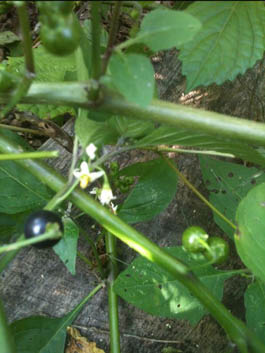
Indian Tobacco (Lobelia inflata)
This little plant is found at the edges of the forest or growing wild in the garden. It needs a fair amount of sun, which is quite obvious when you find it has a peppery taste for all its blue flower coolness. Vinegar preparations of the ripe seed pods were a big favorite with the heroic herbalists of the past. Lobelia is considered an adjuvant. That is, it makes any herbal formula it is in more effective. Check out this week's recipe for my suggested way to use Lobelia to open your ears and eyes to the fairy realm.
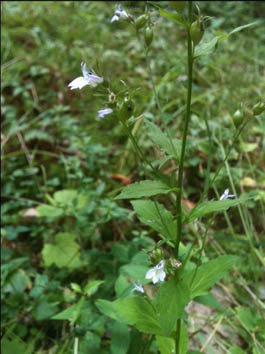

 Glorious green greetings to you all!
Glorious green greetings to you all!


